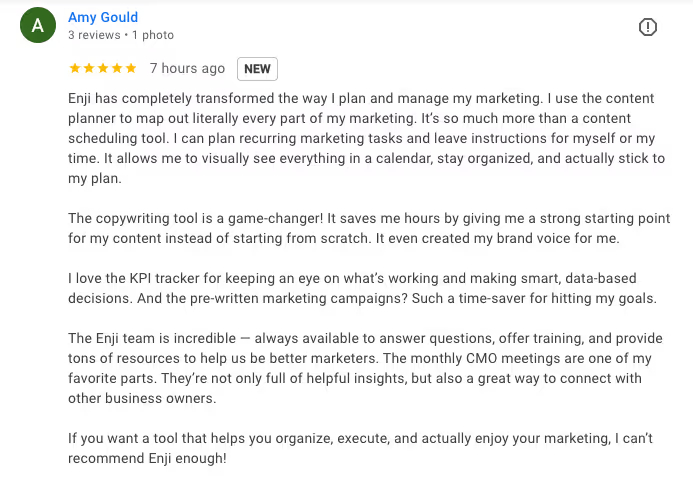Let’s be real: building a business you love shouldn't mean sacrificing your health, creativity, or sanity.
But for so many creative entrepreneurs, that’s exactly what ends up happening.
You start with a passion (photography, design, planning, storytelling), and before you know it, you’re drowning in to-dos, juggling client emails, and answering DMs at 10 p.m. just to keep the wheels turning. You’re delivering amazing work, but it’s coming at the cost of your time, energy, and well-being.
And that, my friend, is what surviving in business looks like.
Let’s talk about what it means to thrive instead (and the systems that can get you there.)
- What thriving as a small business owner actually looks like
- Warning signed you’re just surviving (not a good thing)
- A simple thing you can do to start saving your time as a small business owner
- Why having real systems is a must-have if you want to thrive
Before we get too far into things, I want to let you know that this blog post includes some affiliate links, but I only refer to things I truly love and think will help you, too!
Let’s get into it!

Amy Gould is a Client Experience & Systems Strategist, certified Dubsado Specialist, and the founder of Amy Gould & Co. She helps creative entrepreneurs work less, make more, and wow their clients using smart systems and thoughtful automation. When she’s not streamlining workflows or crafting dreamy onboarding experiences, you can find her chasing her pittie mix Wrigley, wrangling her four cats, or enjoying beach-town life in Michigan. Ready to ditch the burnout and build a business that runs with ease?
Photos by Oliviara Multimedia
What Does Thriving Actually Look Like for Entrepreneurs?
Thriving doesn’t mean doing more. It means doing the right things with support—and not losing your mind while you're at it.
It’s offering the level of service you’re proud of without burning out. It’s waking up knowing your leads are being nurtured, your content is going out, and your client experience is polished (and mostly automated).
It means you’re not rushing from task to task with half a protein bar in your hand and sticky notes on your desk. You have space to rest. To create. To take care of yourself. To live. The way to get there isn’t by working harder. It’s by setting up systems that support you.
What are the Warning Signs You’re Just Surviving?
If any of these sound familiar, you’re probably still stuck in survival mode:
- You’re constantly playing catch-up and feel like you’re dropping the ball.
- You want to raise your rates but worry your experience doesn’t match your pricing.
- You’re frustrated with your systems (or maybe their too manual or you just don’t have them).
- You have lists on lists, spreadsheets, sticky notes…and no clarity.
- You’re exhausted and can’t remember the last time you created something just for fun.
That doesn’t make you a bad business owner. It makes you human. And it also means it’s time for a change.
What Happens When You Stay in Survival Mode?
When you're stuck in survival mode, everything feels like a fire drill. You're reacting instead of responding, working long hours just to stay afloat, and juggling way too many balls in the air. But the consequences go far beyond missed deadlines or a chaotic inbox.
Survival mode wears you down—physically, emotionally, and even relationally.
You might notice you’re constantly tired, even after a full night’s sleep. Your shoulders stay tense, your mind races at bedtime, and your to-do list follows you everywhere—even into the shower. It becomes harder to be present with your partner, your kids, or your friends because your brain is always on. That mental load? It's heavy.
Emotionally, you might start resenting the business you once loved. You second-guess your decisions. You feel like no matter how hard you work, it’s never enough. And that kind of chronic stress chips away at your creativity, your confidence, and your capacity to show up as the business owner (and human!) you want to be.
The longer you stay in this loop, the harder it becomes to step back and see a way out—because survival mode convinces you that there's no time to fix it.
But here’s the truth: burnout doesn’t happen because you're not capable. It happens because you never had the support structure you needed in the first place.
Systems (Not Just Band-Aids) Are a Must-Have for Entrepreneurs
When we talk about “systems,” we’re not talking about slapping a few canned emails together or downloading a free checklist and calling it good. Real systems are intentional. They’re designed to support you and the way you work—and to keep things moving even when you’re off the clock.
As a small business owner, your time and energy are limited. Systems help you protect both. They make your client experience feel polished, professional, and personal—without you having to reinvent the wheel every time someone fills out a contact form. Systems give you freedom: freedom to take a vacation, to sign off early, or to finally launch that new offer you've been dreaming about.
The First System I Recommend for Client-Based Businesses
If you're working directly with clients (especially if you’re handling inquiries, bookings, or custom proposals) the first system I recommend putting in place is a Client Relationship Management (CRM) platform like Dubsado or HoneyBook.
This one tool can completely transform how you run your business.
A CRM helps you:
- Capture new leads through a streamlined contact form
- Respond instantly (even when you're walking the dog or sleeping in)
- Follow up automatically with leads who don’t book right away
- Guide them step-by-step through the process of becoming a paying client
It’s the difference between wondering where your next client is coming from…and consistently waking up to new inquiries in your inbox.
Whenever I work with a creative entrepreneur who’s ready to go from just surviving to actually thriving, we start here. Whether it’s through a Done-for-You Dubsado setup or a strategy session, the lead capture and booking system is always step one.
Why? Because this is where your client journey begins. And automating pieces of it is one of the biggest favors you can do for yourself.
It should be easy for someone to raise their hand and start working with you. If your inbox is a disaster or your contact form feels like a college application, you’re probably losing dream clients without even realizing it—which just adds to the stress.
Sometimes, we start with just that lead capture form and follow-up sequence, and give the business owner time to adjust. Then we build out the rest of the system in layers, including:
- Packages (Pricing Templates): Stop rewriting proposals from scratch. Create a few flexible templates that clearly outline your services, pricing, and deliverables.
- Proposals, Contracts & Payments: Automate the process so a client can approve a proposal, sign the contract, and pay — all in one seamless flow.
- Follow-Up Sequences: Let your CRM follow up on open proposals so you’re not constantly chasing leads or manually tracking what’s pending.
- Onboarding & Delivery Workflows: Set expectations, send prep info, and keep your clients in the loop with thoughtful automations.
- Offboarding: Deliver the final product, collect a testimonial, and wrap things up in a way that leaves a lasting impression (and opens the door for repeat work).
Getting your CRM set up is one of the most impactful things you can do to reduce stress and elevate your client experience—but it’s not the only system you need to thrive.
The Systems Beyond Your CRM That Help You Thrive as a Small Business Owner
A smooth client experience is amazing, but let’s not forget your marketing and operations systems, too.
Here are a few I recommend to every creative entrepreneur:
Creating a Marketing Plan and Tracking Your KPIs with Enji
I love using Enji because it keeps everything, including client avatars, brand assets, social captions, and blog content, in one place. I can quickly schedule posts across all my channels, repurpose content, and actually see what’s working in the KPI dashboard.
It’s taken the guesswork out of my marketing and helped me show up consistently without burning out. I can’t go into all the ways that I use it in my business, but here are a few.
- Turning a blog post into multiple pieces of content across multiple platforms. Game Changer!
- Creating a marketing strategy that makes sense with the time I have.
- Scheduling all of my content and keeping it in one place.
- Writing rough drafts of all the things it takes to market my business.
Email Marketing
Automated nurture sequences are a game-changer. They let you stay in touch with new subscribers and past clients—without writing every email one by one. Not only that, but you can create groups of people and write messages specifically to them. And automate a nurture sequence (a series of emails that introduces you, your business, and how you can help them.) It’s a great way to nurture new email list members.
I’ve seen photographers fill mini sessions in hours just by emailing their list. If you’re not building a list, now’s the time. Two of my favorite email marketing tools are Kit (formerly ConvertKit and FloDesk.) Both of these tools let you create beautiful emails and send automated sequences.
Project Management
Whether it’s ClickUp, Notion, or Trello, having a place to track projects, delegate tasks, and avoid the “where are we at on this?” messages. Not only that, but you can create instructions or SOPs for your tasks so the people doing them can refer back and make sure they’re doing things the right way. It will save your brain (and your relationships).
So… Where Should You Start With Adding Systems in Your Business if You Want to Thrive?
You don’t need to set up everything at once.
Instead, ask yourself this:
What’s the one part of my business causing me the most stress right now?
If it’s lead management → start there.
If it’s writing proposals and contracts → fix that.
If you don’t even have an email list yet → start building one.
Choose the system that will give you the most relief and start small.
Because once the right systems are in place, everything gets easier—and you’ll finally have the space to create, grow, and thrive.
Not Sure Where to Start? I’ve Got You.
Grab my free guide 👉 “Start Here: The First System You Need to Set Up to Stop Surviving and Start Thriving.”
This quick-read resource will help you:
- Identify the biggest stress point in your business
- Figure out exactly which system to set up first
- Take simple, actionable steps to move forward — no overwhelm, no guesswork
📩 Click here to get the free guide delivered to your inbox.
Amy uses Enji to do her own marketing!

"Enji has completely transformed the way I plan and manage my marketing. I use the content planner to map out literally every part of my marketing. It’s so much more than a content scheduling tool. I can plan recurring marketing tasks and leave instructions for myself or my time. It allows me to visually see everything in a calendar, stay organized, and actually stick to my plan.The copywriting tool is a game-changer! It saves me hours by giving me a strong starting point for my content instead of starting from scratch. It even created my brand voice for me.I love the KPI tracker for keeping an eye on what’s working and making smart, data-based decisions. And the pre-written marketing campaigns? Such a time-saver for hitting my goals.The Enji team is incredible — always available to answer questions, offer training, and provide tons of resources to help us be better marketers. The monthly CMO meetings are one of my favorite parts. They’re not only full of helpful insights, but also a great way to connect with other business owners.If you want a tool that helps you organize, execute, and actually enjoy your marketing, I can’t recommend Enji enough!"
Want to try Enji's marketing tools for small business owners? Use Amy's referral link to get a discount on your first 2 months when you subscribe!




